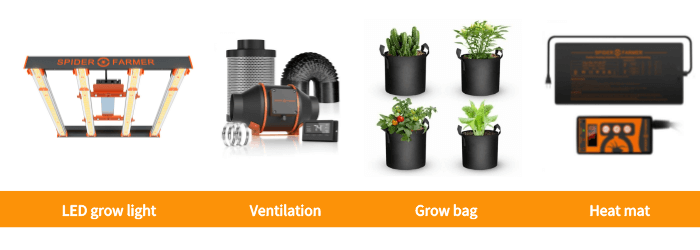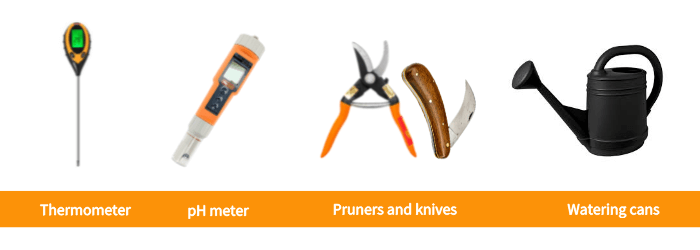The first step to becoming a successful indoor grower is setting up your grow tent. Whether hydroponics or soil, a grow tent is your convenient, often portable, and enclosed space where you grow various plants indoors. It is like having a full-size garden but indoors. You can convert your garage, basement, or even an empty closet into your grow tent.
Contrary to popular belief, setting up a grow tent is not arduous. Instead, it can be an enjoyable DIY task with the proper guidance and information. Read on to learn about indoor grow tents, choosing one, and the items needed for indoor grow tent.
How do you choose a grow tent?
Let’s take a quick illustration. A family looking for a new home will most likely prioritize the number of intended occupants when considering their options. Similarly, when choosing a grow tent, the most important requirement is to know the number of plants you want in the space. You should also consider the size of the space available for use. For instance, a 4” x 4” grow tent can only hold between 4-6 plants, while a 4” x 8” grow tent can only hold between 4-10 plants.
Based on these two essential factors, you can choose the right tent size and furnish it with the essential fittings and equipment a grow tent needs to function optimally.
What items are needed for an indoor grow tent?
Recall that we called your grow tent an indoor space for cultivating your plants. Similar to having some appliances in your living space to make it habitable, you must have certain equipment in your grow room to ensure it performs the intended function—plant growth and development.
For ease of understanding, we have divided indoor grow tent equipment into two groups: (i) the pieces of equipment needed for plant growth; and (ii) the pieces of equipment required for maintenance.
Group 1 – Grow tent equipment needed for plant growth
Lighting
The peculiarities of a grow tent include zero access to sunlight. Since your grow tent is indoors, you must provide an alternative light source for your plants. This is where grow lights come in. A grow light is designed to offer a light spectrum that substitutes the natural sunlight to ensure indoor plants can photosynthesize, grow, and flourish. There are various types of grow lights, including fluorescent lights, high-pressure sodium (HPS), sometimes referred to as HID (High-intensity discharge) lights, and light-emitting diodes (LED) lights.
Ventilation
The confined nature of a grow tent means there is a need for a ventilation system that ensures the continuous flow of air inwards and outwards. A grow room ventilation system maintains a healthy airflow in the grow room and manages humidity and temperature. The standard ventilation systems combine inline fans and ducts or pipes, depending on the size of the grow room, to ensure the airflow supports plant growth and development.
Grow Bag
Grow bags are where you plant your seeds or grow your seedlings. These bags are often made of plastic, or more commonly, jute and fabric. Many growers have opined that indoor plants grow better in grow bags than in plastic pots. The bags are also lighter, making movement, hanging, and storage easier. You can either buy ready-made grow bags or make bags in your desired size.
Heat Mat
Soil heating mats are usually placed underneath the grow bags to provide much-needed warmth for the growing plants. They come in handy when the environment is freezing and the soil cold. They gently warm the soil, facilitating germination and healthy plants.

Group 2 – Grow tent equipment needed for maintenance
Thermometer
You can keep track of your grow room’s temperature using a thermometer. Placed strategically in your grow tent, this device helps to ensure the temperature in your grow tent is not too high or too low. It is best to place your thermometer in a shady location in your grow tent to measure the actual air temperature accurately.
pH Meter
Soil pH requirements differ across plants. While most plants do well in neutral pHs, others require highly acidic soil pH or alkaline soil to grow optimally. A pH meter is designed to give you an accurate reading of your soil pH, and you can adjust your soil pH based on these readings.
Pruners and Knives
Growing in a confined space means you cannot leave your plants to grow outwards as they would like. Knives and pruners are cutting equipment you can use to keep your indoor plants at the desired height and width.
Watering Cans
Your indoor plants require water to grow. Since this is not coming naturally as rain, it is crucial to water your plants generously. Watering cans are portable containers with a funnel and handle. They are designed for the manual watering of plants.

Start your indoor growing journey today.
Your chances of succeeding as an indoor grower depend largely on your grow tent. Picking the right grow tent and furnishing it with the necessary grow tent equipment for plant growth and maintenance make growing less stressful. It also positions you for successful grows and maximum ROI as an indoor cultivator.
Good luck.
Source link
